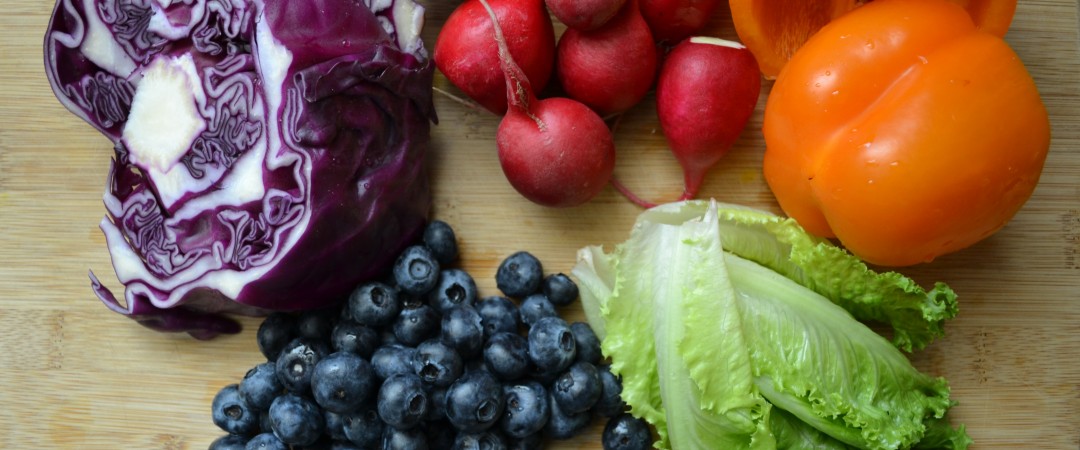What are some of the functions of Phytonutrients? Many are antioxidants, anti-inflammatory agents, anti-microbial, and others support the immune system. Phytonutrients are also cofactors for biochemical reactions in the body, some act as vitamins and some help to lower her cholesterol. Here is a list of some of the chemical terms for a phytonutrient:
- Beta-carotene
- Lycopene
- Xanthophylls
- Lutein
- Zeaxanthin
- Capsaisin
- Curcuminoids
- Anthocyanidins
- Flavanols
- Flavanones
- Flavonols
- Flavones
- Isoflavones
- Ellagic Acid
- Glucosinolates
- Indoles
- Isothiocyanates
- Lignans — phytoestrogen
- Polyphenols
- Saponins
- Sulfides
- Phytosterols
While it may appear that you need an advanced degree in biochemistry to know what’s appropriate to eat, luckily, nature provides us with a very easy color-coded system. It’s important to eat a spectrum of different colors of food due to the varying amounts of nutrients in each food-color group.
Here’s a basic color guide:
Rich red colored foods like tomatoes, red peppers, and watermelon contain lycopene.
Orange colored foods like carrots, peaches, pumpkins, apricots and squash contain carotenoids.
Luetins are found in green leafy vegetables, like Swiss chard, kale, parsley, and spinach.
Deep blue/purple foods include grapes, cherries, blueberries, and raspberries that all contain anthocyanin.
White foods like onions and garlic, contain the phytonutrient quercitin.
It is true that science is now validating what ancient wisdom has told us, so listening to grandma’s advice of ‘always eat your vegetables’ now has scientific merit. Thanks Grandma!
Go Green!
Plants and plant-based foods are more than just the sum of their individual nutrients. Let us look closely at some of the nutritional powerhouses and what makes them so helpful. One of my favorites is arugula. Arugula is a cruciferous vegetable of the Brassicacea family, like cabbage and broccoli. It is also a green leafy vegetable, so it has numerous heart healthy and cancer fighting chemicals including indoles, quercetin and karmpferols. It has a nutty, slightly bitter taste, but baby arugula may have a sweeter taste.
Green leafy vegetables are rich in calcium, in fact, the bitter taste of many leafy vegetables may reflect their levels of calcium. They’re also rich in luetins, vitamin K, vitamin C, some forms of Vitamin B like vitamin B5.
This may be a good time to talk about taste pharmacology. There are 6 different tastes in our diet including sweet, bitter, salty, pungent, astringent and sour. It is helpful to know that there is an evolutionary basis for our sweet tooth. Sweet foods tend to be less likely to be harmful and bitter foods maybe poisonous. So, imagine you are in the wild, foraging for food — plants that taste sweet are more likely edible and less likely to be harmful. The young of our species have a tendency to put things in their mouths; to prefer sweet foods may prevent the toddler from accidentally eating a bitter, possibly poisonous food.
Unfortunately, as we mature, our taste buds often don’t grow out of this sweet phase and therefore we continue to prefer sweets, which are readily available, thus, we consume them. So, help your taste buds grow up and blossom into enjoying the full range of tastes. Don’t baby your buds.
Here are some simple recipes to add green to your diet:
Blended spinach miso soup (Makes 3-4 cups)
3-4 cups of water
3-4 handfuls or cups of spinach
3-4 tablespoon of Miso paste
Combine, boil and blend. This soup is great in a thermos for lunch!
Kale Sauté with Soba Noodles
2 bunches of Kale, washed. Remove stems and tear into bite size pieces.
¼ cup Tamari
2 tablespoons maple syrup
1 inch fresh Ginger, grated and juiced
2-3 cloves of Garlic crushed
2 Tablespoons olive oil
4 ounces soba noodles
Sauté crushed garlic in olive oil until lightly brown. Boil soba noodles. Add kale, tamari, maple syrup and cook on medium heat until kale is wilted and tender. Squeeze juice of grated ginger over kale and toss with cooked, drained soba noodles.




